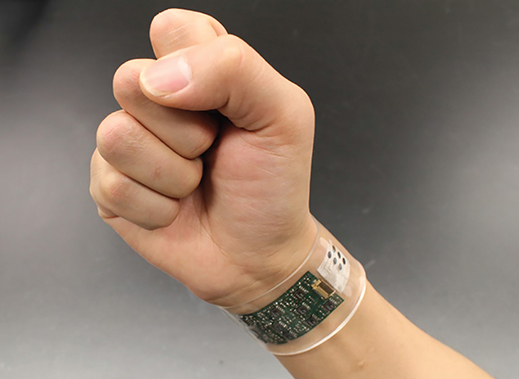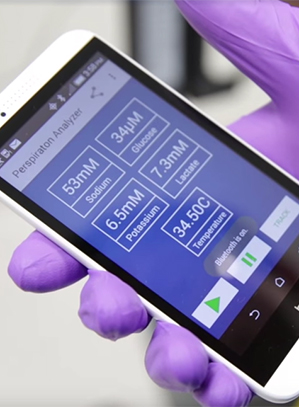New Wearable Sensors Know What’s in Your Sweat
In the not-so-distant future, your activity tracker or smart watch may be able to get a much better picture of your health by measuring the chemical components of your sweat.

A group of researchers has developed a flexible, wearable band filled with sensors that can track sodium, potassium, glucose, and lactate, along with the temperature of the skin. The data is collected and sent to a flexible electronic board that processes it, and from there it’s sent to a smartphone app via Bluetooth.
There are already plenty of activity trackers and smart watches out there that can measure things like heart rate, respiration rate, and skin conductance. But there aren’t yet good, noninvasive ways to keep an eye on what’s actually in bodily fluids, such as sweat.
Knowing about this, and how it changes over time, could be helpful for learning how concentrations of different chemicals relate to your health, says Ali Javey, an electrical engineering and computer science professor at the University of California, Berkeley, and coauthor of a new paper on the research in Nature. Sodium and potassium levels can indicate hydration, for instance, while lactate can point to how tired your muscles are.

In their study, researchers placed the sensors in armbands and headbands, and had people wear them while performing different exercises inside and outside, like running and cycling. A video shows this in action, with a man riding on an exercise bike while wearing a blue headband and a researcher tracking his chemical levels and temperature on an Android smartphone.
Javey says that eventually he envisions the sensors being built into a low-cost, disposable sticker that you’d apply to your hand or the back of a watch, use for a few hours, and then throw away. The corresponding electronics, meanwhile, could be built into a wristband or headband, or simply built into a smart watch.
Jason Heikenfeld, a professor at the University of Cincinnati who studies sweat sensing and directs the school’s Novel Devices Laboratory, thinks this could work, and he says the researchers’ work thus far is an “impressive achievement” because it includes multiple sensors that can be placed on the skin, as well as miniaturized electronics that can wrap around the wrist.
Now, Javey says, researchers are expanding their work to look at about 20 different chemicals in sweat and trying to correlate those chemicals with the health states of different people. He’s hoping to move beyond looking at the sensors for tracking athletic performance, considering whether monitoring chemicals in sweat might be helpful for determining things like whether a person has depression or if they’ve been exposed to harmful chemicals.
“There’s really a whole library of information, in principle, we can get out of sweat,” he says.
Keep Reading
Most Popular
Large language models can do jaw-dropping things. But nobody knows exactly why.
And that's a problem. Figuring it out is one of the biggest scientific puzzles of our time and a crucial step towards controlling more powerful future models.
How scientists traced a mysterious covid case back to six toilets
When wastewater surveillance turns into a hunt for a single infected individual, the ethics get tricky.
The problem with plug-in hybrids? Their drivers.
Plug-in hybrids are often sold as a transition to EVs, but new data from Europe shows we’re still underestimating the emissions they produce.
Stay connected
Get the latest updates from
MIT Technology Review
Discover special offers, top stories, upcoming events, and more.